| Want to send this page or a link to a friend? Click on mail at the top of this window. |
| Posted July 21, 2002 |
|
A Get-Rich Scheme Collapses, Leaving Haiti Even Poorer |
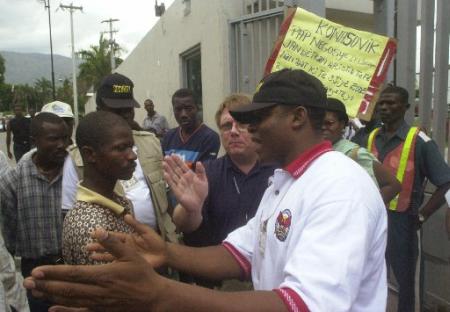 |
| U.S. Embassy officials and guards trying to convince a group of about 50 demonstrators who are victims in Haiti's credit union pyramid scam not to block the gate of the U.S. Embassy in Port-au-Prince, Haiti, on Friday, Aug. 30, 2002. The demonstrators were demanding that U.S., which returned President Jean-Bertrand Aristide to power with a military occupation called "Operation Restore Democracy" in 1994, remove him. In late July, Aristide promised that all pyramid victims would be reimbursed prior to the opening of the schools the first week of September. So far, 22,000 people have filled complaints. (AP Information, Photo/Daniel Morel) |
By DAVID GONZALEZ, The New York Times |
PORT-AU-PRINCE, Haiti, July 20 - Intoxicated by the promise of easy money, thousands of Haitians here and abroad sold their cars, mortgaged their homes and emptied their savings accounts in recent months to invest in cooperatives that promised astonishing monthly returns of 10 percent.
Economists and bankers long warned government officials and the public that the unregulated cooperatives were little more than a pyramid scheme and possible money-laundering operation. But when President Jean-Bertrand Aristide hailed cooperatives as "the people's capitalism" that would drive economic development, many investors said their skepticism vanished.
Soon, too, did their money. More than $200 million has been lost in unsound or illegal cooperatives that took their investors' money and bought luxurious properties, fleets of buses or just spirited it abroad. Police officers have shown up in riot gear at some cooperatives, holding managers at gunpoint until they were repaid.
But with thousands of other people having lost their homes or savings and unsure how they will pay their rent or send their children to school in September, the collapse has presented Mr. Aristide with what could be the most serious challenge to his already bumpy tenure.
"I sold my house because the president encouraged us to do so," said Serge Décime, a bus driver from the southern coastal town of Jacmel who said he had invested $6,500 in a cooperative that failed. "Now, we live, but only a little bit. We cannot afford to live anymore."
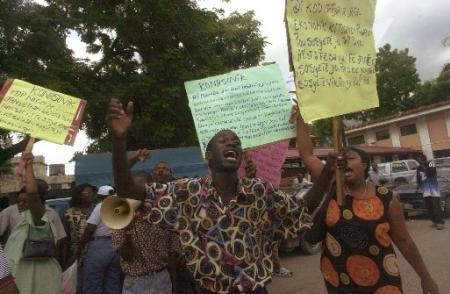 |
| Some of the tens of thousands of victims in Haiti's credit union pyramid scam march outside the U.S. Embassy in Port-au-Prince, Haiti, on Friday, Aug. 30, 2002. The man's yellow sign at right denounces President Jean-Bertrand Aristide's literacy program as a "Mafia" scheme and warns him to help the victims of the pyramid scam. In late July, Aristide promised that all victims would be reimbursed. So far, 22,000 people have filed complaints. (AP Information, Photo/Daniel Morel) |
Last Friday, the government promised a bailout, although no reputable economist can see how Mr. Aristide can hope to do so without giving rise to runaway inflation.
Apparently, the president hopes to avoid the kind of disorder that engulfed Albania, Europe's poorest country, after a similar, more costly pyramid scheme collapsed there in 1997. "He says everybody will be repaid," said Jacques Durocher, the director of Desjardins International Development, which advises legitimate cooperatives. "Everybody knows it is an old strategy to keep people quiet. Time will do the job."
Diplomats are especially galled by the promised bailout, considering that the government of the Western Hemisphere's poorest country has blamed its social and economic deterioration on the international community, which has frozen $500 million in aid until a political impasse over the legislative elections of May 2000 is resolved.
"It is an absurdity," said one diplomat who has tracked the cooperatives. "This is a government that doesn't have any money. That's bad enough, but there are schools, hospitals and 20,000 other priorities that would be more important than this from an economic and social standpoint. You're already broke and going to get even broker."
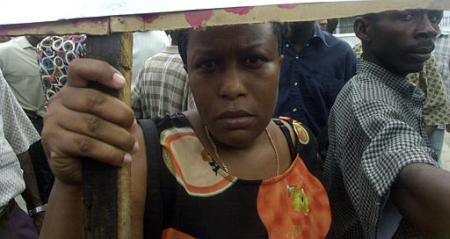 |
| One of the tens of thousands of victims in Haiti's credit union pyramid scam marches in a demonstration outside the U.S. Embassy in Port-au-Prince on Friday, Aug. 30, 2002. The demonstrators were demanding that the U.S., which returned President Aristide to power with "Operation Restore Democracy" in 1994, remove him. In late July, Aristide promised that all pyramid victims would be reimbursed prior to the opening of the schools the first week of September. So far, 22,000 people have filed complaints. (AP Information, Photo. (Daniel Morel) |
In an interview, Mr. Aristide said he had told people to be careful about investing, and that his government was placing all financial cooperatives under supervision of the banking authorities. "If I went too fast and too far, I would be creating and increasing the panic," he said.
Traditional cooperatives have long existed in Haiti, allowing farmers or small business owners who were unable to borrow from banks to pool their savings into revolving loan accounts. Savings accounts in the traditional cooperatives offered at most a 4 percent annual interest rate, similar to commercial banks.
The 10 percenters, as they are widely known, emerged about three years ago, mushrooming in the last year to more than 250. They competed for customers by offering cellphones and compact disk players to new depositors and an up-front payout of three months interest. Rates shot up to as high as 13 and 15 percent.
Guernélia Jeudi sold her home for $16,000 and invested it in a cooperative offering 12 percent a month, hoping to pay off her debts and build a nicer home for her and her five children. A few weeks ago, the cooperative disappeared overnight. "Now I work with my hands, begging for the charity of God," she said in the courtyard of a house she is renting. "We will have to move in December when the rent is due again. My son is sick with a cough, and I cannot even take him to the doctor. I have no money for anything."
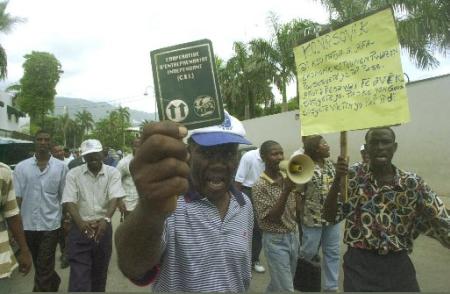 |
| Victims in Haiti's credit union pyramid scam march outside the U.S. Embassy in Port-au-Prince, Haiti, on Friday, on Aug. 30, 2002. The man at left holds up his passbook while person on the right holds a sign saying: "victims will not accept the loss of one Gourde," Haiti's currency. The demonstrators were demanding that the U.S., which returned President Jean-Bertrand Aristide to power with a military occupation called "Operation Restore Democracy" in 1994, remove him. In late July, Aristide promised that all pyramid victims would be reimbursed prior to the opening of the schools the first week of September. So far, 22,000 people have filed complaints. (AP Information, Photo/Daniel Morel) |
The managers of the 10 percenters were vague about how they were able to offer such high rates. Many said the government had allowed them to import rice, sugar and consumer goods duty-free. Others also said they had invested heavily in profitable bus fleets.
Reputable financial experts noted that the numbers did not add up, but figured that the 10 percenters were pyramid schemes that would quickly implode as the pool of new depositors shrank. "Mathematically, it should have self-destructed earlier," one banker said. "Drug money definitely allowed them to last much longer."
Such rumors swirl around Coeurs-Unis, a new 10 percenter said to have close ties to Mr. Aristide's Lavalas Family political party. Coming from seemingly nowhere, it opened up across the country with large bus fleets before accepting a single deposit. The firm recently purchased a near-vacant resort hotel in Jacmel for nearly $4 million, about four times its actual value, bankers said.
Armed guards at Coeurs-Unis offices in Port-au-Prince rebuffed several attempts to interview David Chery, its head.
The crisis began in February when commercial banks feared they would be cut off from their United States counterparts if they were found to have accepted drug profits.
Sogebank, Haiti's largest locally owned bank, asked some 20 cooperatives that had deposits to show their books. None complied, and the bank returned $9 million.
There may be ripples through the legitimate cooperatives and commercial banks. At least one major traditional cooperative is believed to have invested its depositors' money in a 10 percenter. At some commercial banks, almost half of the employees took out unsecured loans to invest in cooperatives.
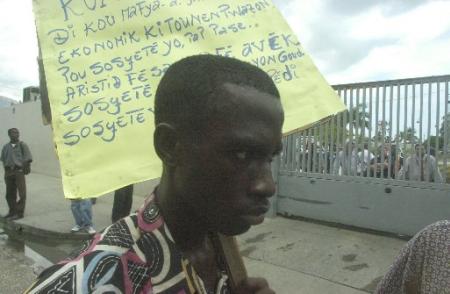 |
| An angry credit union pyramid scam victim takes part in a demonstration outside the U.S. Embassy in Port-au-Prince, Haiti, while U.S. embassy officials watch from behind the gate on Friday, Aug. 30, 2002. The sign demands that victims be reimbursed and says they will "not accept the loss of one Gourde," Haiti's currency. The demonstrators were demanding that the U.S., which returned President Jean-Bertrand Aristide to power with a military occupation called "Operation Restore Democracy" in 1994, remove him. In late July, Aristide promised that all pyramid victims would be reimbursed prior to the opening of the schools the first week of September. So far, 22,000 people have filed complaints. (AP Information, Photo/Daniel Morel) |
Bankers said the government repeatedly ignored their warnings about dangers to the financial system. Instead, the government continued to praise the cooperative movement, making no distinction between legitimate traditional cooperatives and the 10 percenters, who had unleashed a barrage of advertising.
Cooperative managers insist that the movement is still viable. Zachée Michel, who leads an association of cooperatives, said he had been negotiating with two financial firms in the United States to see if their assets can be purchased as part of a restructuring.
"We have consulted specialists from Wall Street, and what they offer by looking back over the last five years is 75 to 80 percent a year return," Mr. Michel said. "If they do that, we can safely offer 60 percent a year. The economy of Haiti is not good enough, but internationally it is good enough by investing in the New York stock market."
*wehaitians.com: AP Information and Photos, which did not accompany this article, at the time of publication by The New York Times, were added on August 30, 2002.
| Wehaitians.com, the scholarly journal of democracy and human rights |
| More from wehaitians.com |